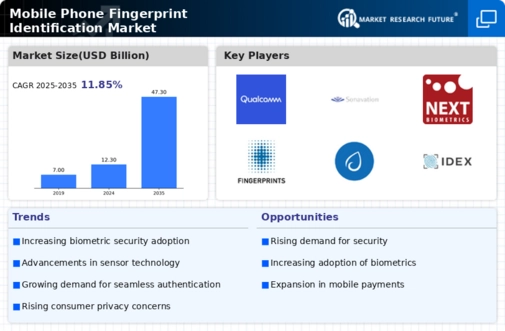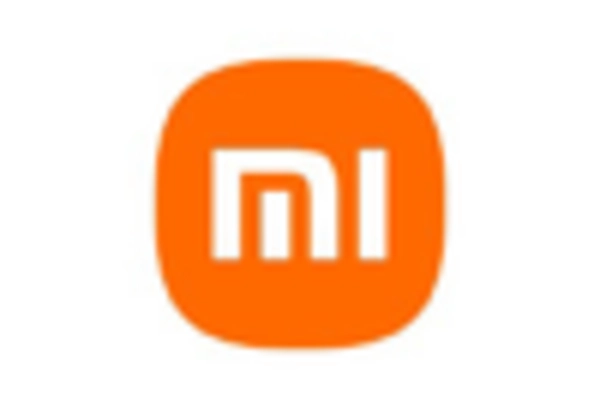Rising Security Concerns
The Mobile Phone Fingerprint Identification Market is experiencing a surge in demand due to increasing security concerns among consumers and businesses alike. As cyber threats evolve, the need for robust authentication methods has become paramount. Fingerprint identification offers a unique advantage, as it is difficult to replicate and provides a higher level of security compared to traditional passwords. In 2025, it is estimated that the market for biometric authentication will reach approximately 30 billion USD, with fingerprint technology accounting for a substantial share. This trend indicates that consumers are prioritizing security, thereby driving the adoption of fingerprint identification systems in mobile devices.
Increased Adoption of Smart Devices
The increased adoption of smart devices is significantly influencing the Mobile Phone Fingerprint Identification Market. As smartphones and tablets become ubiquitous, the integration of fingerprint sensors has become a standard feature in many devices. This trend is expected to continue, with an estimated 80% of smartphones featuring fingerprint recognition technology by 2026. The convenience and security offered by fingerprint identification are appealing to consumers, leading to higher adoption rates. Consequently, this widespread acceptance is likely to propel the growth of the fingerprint identification market, as manufacturers strive to meet consumer expectations for enhanced security features.
Regulatory Compliance and Standards
Regulatory compliance and standards are emerging as critical drivers in the Mobile Phone Fingerprint Identification Market. Governments and regulatory bodies are increasingly mandating the use of biometric authentication for various applications, particularly in sectors such as banking and healthcare. Compliance with these regulations not only enhances security but also fosters consumer trust in biometric systems. As organizations strive to meet these standards, the demand for fingerprint identification technology is expected to rise. In 2025, it is anticipated that the market will see a notable increase in adoption rates, driven by the need for compliance with evolving regulations surrounding data protection and privacy.
Expansion of Mobile Payment Solutions
The expansion of mobile payment solutions is a key driver in the Mobile Phone Fingerprint Identification Market. As more consumers opt for contactless payment methods, the need for secure authentication has intensified. Fingerprint identification provides a seamless and secure way to authorize transactions, making it an attractive option for mobile payment applications. In 2025, the mobile payment market is expected to surpass 10 trillion USD, with a significant portion of transactions being secured through biometric methods. This trend suggests that as mobile payment solutions proliferate, the demand for fingerprint identification technology will continue to rise, further solidifying its position in the market.
Technological Advancements in Biometric Systems
Technological advancements are playing a crucial role in the Mobile Phone Fingerprint Identification Market. Innovations in sensor technology, such as capacitive and optical sensors, have enhanced the accuracy and speed of fingerprint recognition. These advancements not only improve user experience but also expand the applicability of fingerprint identification in various sectors, including finance and healthcare. The market is projected to grow at a compound annual growth rate (CAGR) of around 15% over the next five years, driven by these technological improvements. As manufacturers continue to integrate advanced biometric systems into their devices, the demand for fingerprint identification is likely to increase significantly.


















Leave a Comment